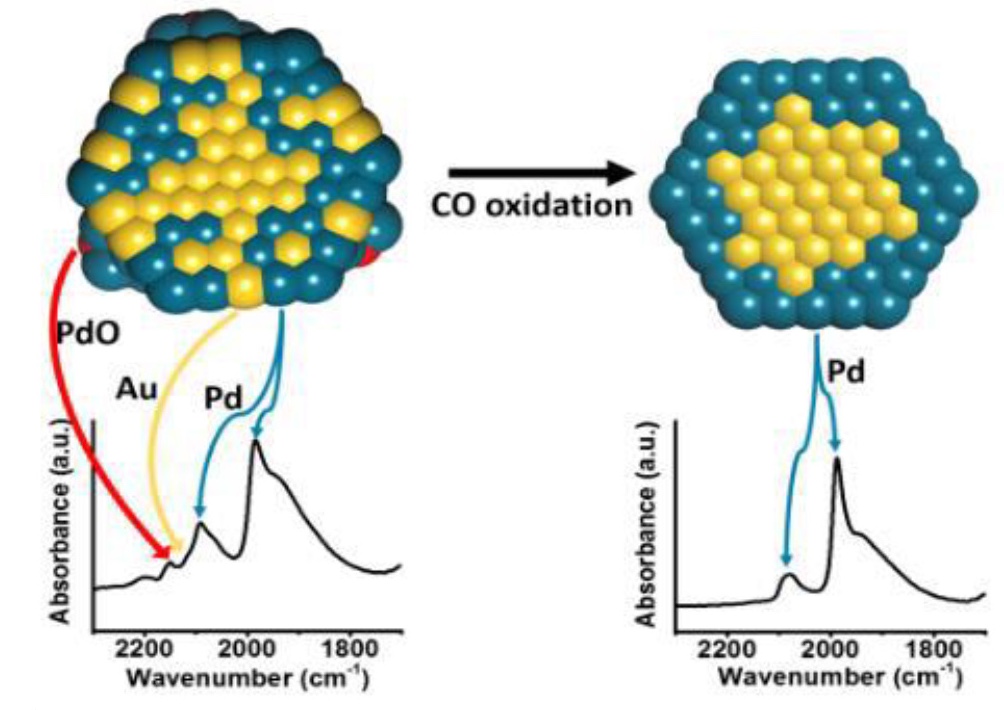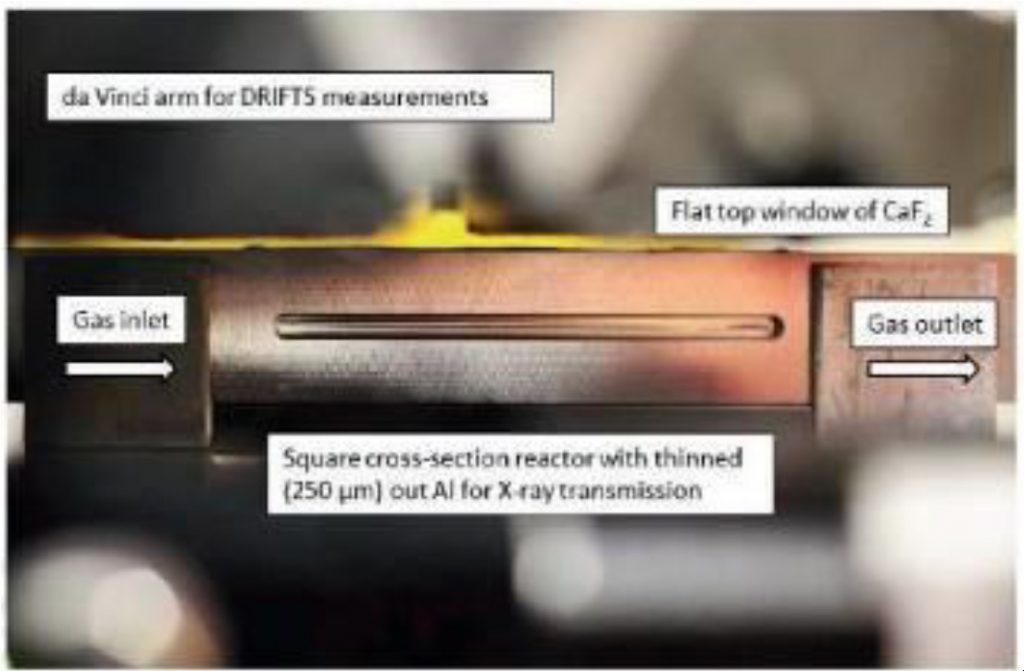Dr Peter Wells (UCL, ECR at that time) had one of the Exemplar projects with the Hub in 2013 titled Technical Developments for Probing the Nature of the Active Site and Catalytic Mechanisms. This project hired Dr Emma Gibson (UCL).
Technical developments for Probing the Nature of the Active Site and Catalytic Mechanisms

Developed the uses of in situ and operando spectroscopic methods for investigating and developing improved catalyst materials. This project aimed to develop a combined XAFS/DRIFTS system where the local structure and oxidation state information provided by X-ray Absorption fine structure (XAFS) and surface sensitive information obtained from FTIR. This powerful combination of techniques has been demonstrated by the study of the restructuring of a bimetallic AuPd/Al2O3 catalyst during CO oxidation the structural changed affect the activity and are shown in the Figure. This powerful combination of techniques is now available for use by the wider UK Catalysis Hub network and has already been used by several groups to study a variety of catalytic systems.
New combined XAFS/DRIFTS reactor
A collaborative partnership between the UK Catalysis Hub, Diamond Light Source, partner universities (Southampton, QUB, Manchester, Glasgow, UCL), and Johnson Matthey Technology Centre (JMTC) have been working towards developing advanced reactor environments for the study of catalytic processes which was developed from outcomes of the initial project.
Led by Dr Peter Wells (Southampton, Diamond) and Prof. Alex Goguet (QUB), the endeavour behind these activities is to develop operando techniques that allow for precise, accurate, and reliable measurements regarding the evolving nature of catalysts under realistic conditions.

This work was funded through the UK Catalysis Hub – JMTC studentship call in 2014 and has focused on developing a new approach to combining X-ray absorption fine structure (XAFS) and diffuse reflectance infrared Fourier transform (DRIFTS) spectroscopies.
This combination of techniques provides complementary information; XAFS provides structural and electronic information, whilst DRIFTS provides information on the nature of surface adsorbates. However, the current reported approaches in the literature are hindered by large reactor dead volumes and cannot provide any spatial information on the state of the catalyst; considering that in a fixed bed reactor there is a gradient between reactants and products, it is important to be able to capture these changes and understand the interplay between structure and the surface adsorbates at each position.
This partnership has developed a reactor that solves both the problems linked to spatial analysis and large dead volumes (figure x) by moving away from typical ‘dome’ shaped sample chambers and exploiting a square cross-section reactor with axial windows for both XAFS and DRIFTS acquisition. The more conventional reactor geometry is not hindered by the dead volume of the dome and can collect data along the length of the fixed bed.
Furthermore, the cell has been recently integrated (April 2018) into the I20-EDE beamline at Diamond Light Source, which – in conjunction with a rapid scanning FTIR spectrometer – allows for ms time resolution of both the FTIR and XAFS data acquisition.
The success of this project is, in no small part, down to the determination and talent of the PhD student, Miss Ellie Dann, who has undertaken this work.
The first publication from this new development is currently under review and we look forward to updating Hub members further about these exciting developments.
Publications:
Gibson EK et al. 2015, Restructuring of AuPd nanoparticles studied by a combined XAFS/DRIFTS approach. Chem. Mater. 27, 3714–3720. DOI: 10.1021/acs.chemmater.5b00866
Dann, Ellie K., Get al., Combined spatially resolved operando spectroscopy: New insights into kinetic oscillations of CO oxidation on Pd/γ-Al2O3, Journal of Catalysis, 2019, Volume: 373, 201-208, DOI: 10.1016/j.jcat.2019.03.037
Gibson, E. K., Crabb, E. M., Gianolio, D., Russell, A. E., Thompsett, D., & Wells, P. P. (2017). Understanding the role of promoters in catalysis: operando XAFS/DRIFTS study of CeOx/Pt/Al2O3 during CO oxidation. Catalysis, Structure & Reactivity, 3(1–2), 5–12. DOI: https://doi.org/10.1080/2055074X.2017.1278890
Career development:
Following his time with the Hub Peter Wells joined the University of Southampton in August 2016 as Lecturer of Inorganic Chemistry, a joint appointment with Diamond Light Source, and was promoted to Associate Professor in March 2019
Emma Gibson went on to receive a Lord Kelvin / Adam Smith (LKAS) Fellowships at University of Glasgow and is now a senior lecturer. Emma has had projects with the UK Catalysis Hub including “UK-US collaboration: micro-reactor for combined XAFS/XRD and Vibrational spectroscopy” a project in collaboration with SLAC National Accelerator Laboratory, California, US, Stockholm University, Stockholm, Sweden and, Texas Tech University, Texas, US which was developed following meeting with The DoE in the US and The UK catalysis Hub during covid.
Other Notable Projects
Artificial Metalloenzymes for (selective) Oxidative Catalysis P Kamer (St Andrews) PDRA: A Jarvis (St Andrew)
Oxidation of alkanes to alcohols has been an important challenge in homogeneous catalysis for many years. Several catalytically active systems have been discovered but in general selectivity for alcohol and conversions are low. Recently, we developed an efficient and robust method to incorporate transition metal cofactors into proteins. Enzymes involved in fatty acid metabolism, such as human Steroid Carrier Protein 2L (SCP-2L) contain selective binding sites for long-chain hydrocarbons. Modification of their active site with suitable ruthenium, iron, manganese or cobalt catalysts is anticipated to result in improved selectivity to the terminal alcohols.

The shape of the apolar molecular tunnel can direct the alkane substrate with C1 to the transition metal cofactor similar to the early attempts of Tolman and Thomas to get improved selectivity for the formation of n-alcohols via alkane oxidation in Fe exchanged zeolites.11 In a similar way the shape of the apolar molecular tunnel can direct the alkane substrate with C1 to the transition metal cofactor. This project aimed to improve the selectivity ultimately using O2 as oxidant both by modification of the ligand and mutagenesis of the protein structure. The latter approach already proved to be useful in Cytochrome P450 mediated alkane hydroxylation. notably EXAFS, and SeMet replacement of the Met residues in SCP-2L A100C have allowed the identification of methionine residues interacting with the metal centre, believed to contribute to the stability of Rh binding and catalytic activity in the artificial hydroformylase.
Key Publication:
Jarvis AG, et al. Enzyme Activity by Design: An Artificial Rhodium Hydroformylase for Linear Aldehydes. Angew Chem Int Ed Engl. 2017 Oct 23;56(44):13596-13600. DOI: 10.1002/anie.201705753.
Career development:
Amanda received a Marie Curie Individual Fellowship to continue working in Prof. Paul Kamer’s group on Artificial Metalloenzymes for the Oxidation of Alkanes (ArtOxiZymes). In 2017 she started her independent career as a Christina Miller Fellow at the University of Edinburgh and was awarded a UKRI Future Leaders Fellowship in 2019. In 2022, she was promoted to Senior Lecturer.
Find more about Amanda Jarvis at: https://www.amandajarvis.co.uk/dr-jarvis
New Advances in Redox Catalysis
G Hutchings (Cardiff) PDRA: S Kondrat
This project with Cardiff as part of the environmental theme pioneered the design of AuPd nanoparticles as redox catalysts, and to designed new bimetallic catalysts, based on data recently obtained for the direct synthesis of H2O2 from H2 and O2 showing that supported AuPd alloys are very effective. The effect is not morphological in origin but electronic. The project focused on the valorisation of glycerol to either tartronic acid or lactic acid, via an oxidation or a dehydration pathways respectively. High surface area lanthanum based perovskites as supports for bimetallic AuPt nanoparticles. By changing the B site of the LaBO3 (where B= Cr, Mn, Fe, Co or Ni) we can tailor the reaction pathway to produce either tartronic acid or lactic acid. Our results indicate that support modification to tailor selectivity is a promising approach for designing catalysts for various liquid phase oxidation reactions. The work was patented and then presented at a Faraday Discussion (Faraday Discussions (2016), 188, 427-450) and follow on funding has been supplied by the EPSRC IAA.
Publications:
Evans, CD, Kondrat, SA, Smith, PJ, Manning, TD, Miedziak, PJ, Brett, GL, Armstrong, RD, Bartley, JK, Taylor, SH, Rosseinsky, MJ, Hutchings, GJ (2016), The preparation of large surface area lanthanum based perovskite supports for AuPt nanoparticles: tuning the glycerol oxidation reaction pathway by switching the perovskite B site, Faraday Discussions, 188, pp.427-450, ISSN: 1359-6640. DOI: 10.1039/c5fd00187k.
Kondrat, S, Smith, PJ, Lu, L, Bartley, JK, Taylor, SH, Spencer, MS, Kelly, GJ, Park, CW, Kiely, CJ, Hutchings, GJ (2018) Preparation of a highly active ternary Cu-Zn-Al oxide methanol synthesis catalyst by supercritical CO2 anti-solvent precipitation, Catalysis Today, ISSN: 0920-5861. DOI: 10.1016/j.cattod.2018.03.046.
Career development:
Simon was appointed as Lecturer in Inorganic Chemistry at Loughborough University in October 2017. His research focuses on the preparation and advanced characterisation of heterogeneous catalysts for application in the hydrogen economy and energy applications.
Simon benefited from his time in the Hub and throughout his career made good use of the research facilities and core PDRA time with the hub. As an early career researcher he made use of laboratory equipment (XPS/BET/microscopy) at the research complex that enabled him to establish himself and publish preliminary results. As a ECR he has had projects with the Hub providing core PDRA time funded on several research projects, which have resulted in several publications and a growing collaboration with an industrial company (Plastic Energy). These projects have provided proof of concept data for several EPRSC and innovate grant applications.
The UK Catalysis Hub Block Allocation Group (BAG) at B18 at Diamond Light Source has been immensely helpful to Simon in a multitude of ways. Firstly, as is with the BAGs remit, it enabled him to learn about and use powerful X-ray absorption spectroscopy techniques as a new user. Simon is now an emerging expert in the use of XAS in catalysis and battery science with PhD students funded by Diamond and a direct access user of the facilities, this success would have been unlikely to have happened without the supportive and constructive research environment provided by this access mechanism. He continues to use the BAG and regularly publish 2-3 papers per year with data from it.
Lastly, Simon is involved in the management of the BAG and sit on proposal panels, which has provided many soft skills and an understanding of user facilities. He has further been given the opportunity to develop management skills and influence the community through his membership of the Hubs steering group.
To date Simon has published > 20 papers that acknowledge the UK Catalysis Hub.
Find more about Simon Kondrat at: https://www.lboro.ac.uk/departments/chemistry/staff/simon-kondrat
Case Study:

Dr Arun Chutia – Hub PDRA in 2013-2017 now a Senior Lecture at The University of Lincoln.
The UK Catalysis Hub: Its Impact on My Research Career
The UK Catalysis Hub has been an instrumental force in shaping my career in catalysis. During my stay in the Hub, as a postdoctoral research associate with Prof. Richard Catlow, it not only provided a conducive working environment with leading scientists but also facilitated exposure to the latest studies in catalytic sciences, involvement with innovative research and networking opportunities. In the following sections, I will briefly elaborate on how the UK Catalysis Hub has played a pivotal role in my professional development.
A Great Place to Work with Leading Scientists in Catalysis: The UK Catalysis Hub has been a sanctuary for catalysis experts. Being affiliated with this hub allowed me to work alongside some of the brightest minds in this field. The collaborative environment in the Hub fosters intellectual growth and provides access to state-of-the-art facilities and resources. Through interactions with leading scientists, I gained valuable insights and perspectives, which have significantly contributed to the advancement of my research endeavours. These interactions broadened my horizons and have allowed me to produce research of greater impact.
A Great Place to Meet Scientists with Similar Interests: The UK Catalysis Hub provided me with the incredible opportunity to meet and collaborate with fellow scientists who share a passion for catalysis. This network has been invaluable in the exchange of ideas and forming lasting collaborations. The diverse backgrounds and expertise of the scientists I met through the hub enriched my own understanding of catalysis and encouraged me to explore new research directions.
A Great Place to Get Involved in Innovative Research on Catalysis: One of the most significant benefits of my association with the UK Catalysis Hub has been the opportunities to engage in innovative research on catalysis. The hub is at the forefront of catalysis research, and its projects encompass a wide range of topics, from predicting and designing novel catalysts to catalysis for net zero. Being part of this research community has allowed me to work on cutting-edge projects, pushing the boundaries of knowledge in the field. The hub has not only honed my research skills but has also positioned me to contribute to solutions for some of society’s most pressing challenges.
Its Biannual Conference Brings Scientists from Around the UK and Abroad: The biannual conference organized by the UK Catalysis Hub serves as a platform for scientists from across the UK and abroad to come together and share their latest research findings. Attending these conferences broadened my perspective on global catalysis research trends and allowed me to witness the incredible work being done worldwide. It has also provided me with opportunities to present my own research to a diverse and knowledgeable audience, fostering constructive feedback and facilitating collaborations with researchers from other institutions.
In conclusion, the UK Catalysis Hub has played a crucial role in my career. My association with this hub has greatly enriched my passion for this fascinating field. I am deeply grateful for the opportunities and experiences it has afforded me, and I look forward to continued growth and collaboration within this vibrant community.
Case Study:
Dr Laurie King – Manchester Metropolitan University PI on Hub Project: Sonoelectrochemical carbon dioxide reduction for sustainable chemical manufacturing, 2021
UK Catalysis Hub Impact on the King-Regmi Research Group
In September 2019 I began my independent research career at Manchester Met, establishing a research group developing economic and sustainable materials for energy technologies. I co-run this research group with Dr Yagya Regmi, who started his own independent career in December 2019 also at Manchester Met. This move to the UK was after 6 years of working in the USA and therefore my academic and industrial contacts within the UK was minimal. Engaging with the Catalysis Hub has led to numerous opportunities and had a fantastic impact on our research group. Indeed, through attending and presenting at their conferences, discussing potential projects with some of the investigators, I have been able to network with both industry and academics. Specifically, these have directly resulted in invitations to give department seminars (e.g., Durham University), the opportunity to meet potential collaborators (e.g., Prof Rosseinsky at the University of Liverpool, who’s group have since shared samples with our PDRA, Prof Sarah Haigh who we now collaborate with on an iCASE award, and Prof Chris Hardacre who we have had discussions with regarding further potential collaborations) as well as conversations pertaining to new industrial collaborations (e.g., Nikalyte). Finally, discussions with the Catalysis Hub Principal Investigator Prof Andrew Beale (UCL) led to his mentorship throughout my developing of my New Investigator Award (NIA) which was successful at EPSRC. Prof Beale is also listed as a collaborator on the NIA award, where he has agreed to contribute through advanced X-ray and optical spectroscopic and scattering methods under in situ and operando conditions. Over the past 18-months, I have also had the opportunity to serve on the Catalysis for Net Zero ECR Committee, further expanding me network throughout the UK Catalysis community.
Our research group has also had the opportunity to engage with the UK Catalysis Hub through two of their funding calls (“Catalysis Hub Projects”). In 2020 we were awarded our first Catalysis Hub project (led by Dr Yagya Regmi, I was the Co-I) which in addition to a 1-year PDRA that worked in our research group, also granted us the opportunity to collaborate with one of the Catalysis Hub Core PDRA’s who had significant experience and knowledge of synchrotron spectroscopies, including x-ray absorption spectroscopy. This hugely increased the impact of our research, enabling us to conduct in situ and operando studies at both Diamond Light Source and ESRF as part of this project. The project also enabled us to establish another collaboration with Prof Beale, as well as with Prof Magnus Rønning (NTNU, Norway), a leading expert in Catalysis. Additionally, Dr Yagya Regmi has been awarded the Royal Academy of Engineering Industry Fellowship to work with URA Thrusters to develop hydrogen-based space thrust systems. URA Thrusters are subsidiaries of AVS UK who were our industrial partners on the 2020 UK Catalysis Hub grant. In a second Catalysis Hub project (2022), we have established a new collaboration with Prof James Kwan (University of Oxford) where we are currently exploring a novel approach to electrochemical CO2 reduction, namely, sonoelectrochemistry. Here, we are designing a new sonoelectrochemical reactor that optimised acoustic cavitation to generate reaction intermediates for electrochemical up-conversion, and thus we are significantly expanding the scope of our research knowhow. As a result of this collaboration, we have very recently submitted a proposal for an EPSRC Standard Research Grant, hoping to translate our initial findings to alternative chemical reactions.




